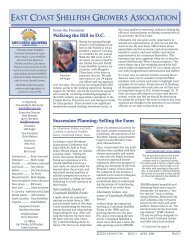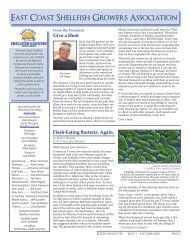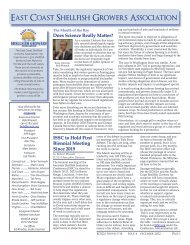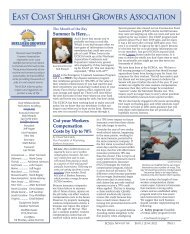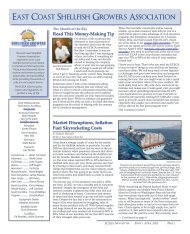ECSGA October 2022 Newsletter
This issue contains articles on social license for aquaculture, cultural benefits and social impacts of shellfish aquaculture, how best management practices differ from laws and regulations, mortality rates in floating gear vs. bottom gear, the story of how the Oceanfarmr (formerly known as SmartOysters) app came to be, and the difference between gross sales and net profit,
This issue contains articles on social license for aquaculture, cultural benefits and social impacts of shellfish aquaculture, how best management practices differ from laws and regulations, mortality rates in floating gear vs. bottom gear, the story of how the Oceanfarmr (formerly known as SmartOysters) app came to be, and the difference between gross sales and net profit,
Create successful ePaper yourself
Turn your PDF publications into a flip-book with our unique Google optimized e-Paper software.
— Continued from page 6<br />
Best Practices<br />
Most enforcement officers have<br />
only a vague concept of what<br />
we do. They are often only<br />
familiar with regulating fisheries,<br />
where their tools consist of<br />
seasonal harvest restrictions, bag<br />
limits and minimum sizes to try<br />
to ensure a sustainable harvest.<br />
These tools have no meaning in<br />
aquaculture. Fisheries patrol officers<br />
are simply not capable of<br />
being in every harvest area every<br />
day. We can hope that the threat<br />
of stiff fines and penalties leads<br />
to good compliance, but judging<br />
by the frequency of fisheries<br />
violations I’ve gotten wind of, I<br />
have to believe otherwise.<br />
Best practices alone are not<br />
likely to achieve full compliance<br />
either. However, there is<br />
a substantial body of literature<br />
suggesting that a prudent combination<br />
of regulations and best<br />
practices can achieve the goals<br />
of protecting natural resources<br />
and public safety much more effectively<br />
than either on its own.<br />
Best practices are<br />
“living documents”<br />
The <strong>ECSGA</strong> drafted a Best<br />
Management Practices manual<br />
in 2010, available for free on our<br />
website. Many of our members<br />
have found that the manual is<br />
easy to use and allows them to<br />
develop individualized farm-specific<br />
best practices that they find<br />
useful for marketing, permit acquisition<br />
and employee training.<br />
When we wrote the manual, we<br />
intended it to be a living document,<br />
since we recognized the<br />
dynamic nature of our industry.<br />
This past year the <strong>ECSGA</strong><br />
won a grant from The Nature<br />
Conservancy’s SOAR program<br />
to update the BMP manual to<br />
include floating gear (which was<br />
not yet a big deal way back in<br />
2010). We have conducted a series<br />
of workshops and developed<br />
draft best practices for floating<br />
gear, and are now embarking on<br />
a full revision of our best practices<br />
manual.<br />
If you would like to be a part of<br />
that process we can offer a handful<br />
of growers a stipend to help<br />
us update the manual over this<br />
coming winter, and we would<br />
love to have some experienced<br />
growers join the effort.<br />
Send me an e-mail!<br />
bob@ecsga.org.<br />
Gross Sales vs.<br />
Net Profit<br />
A few years ago I had the pleasure<br />
of teaching a class of eager<br />
new shellfish-farm workers, and<br />
began the course by showing<br />
them how the rapid growth of<br />
the industry was leading to more<br />
demand for workers to fill those<br />
jobs. At that time, 40 farms in<br />
Rhode Island were selling about<br />
$7 million of oysters a year. After<br />
the training class, one of the<br />
students went looking for work<br />
and was shocked to discover that<br />
the starting salary was just over<br />
the minimum hourly wage.<br />
He did the math and figured that<br />
his boss was making hundreds<br />
of thousands of dollars on the<br />
backs of hard-working, lowwage<br />
employees. And because<br />
no good deed goes unpunished,<br />
I learned that he was hell bent<br />
on writing a Ceasar Chavez-style<br />
exposé on the rapacious shellfish-farmer<br />
robber barons.<br />
What I had failed to explain to<br />
the students, (and have since<br />
added to the curriculum) is that<br />
while shellfish farms have some<br />
of the highest per-acre revenues<br />
of any crop (other than cannabis),<br />
they also have some of the<br />
highest input costs of any farms.<br />
When you add up the expenses<br />
of boats, insurance, cages and<br />
gear, boat slips, seed, labor and<br />
everything else that goes into<br />
bringing a crop to market, most<br />
growers are actually working on<br />
pretty tight margins (net profit).<br />
Smaller farms often can barely<br />
make ends meet, and the owners<br />
are far from getting rich.<br />
For all you farmers out there,<br />
here’s a pro tip: if you increase<br />
your sales by $1,000, you only<br />
increase your profits by (1,000 x<br />
your net profit margin, typically<br />
5% to 20%), which works out to<br />
$50-$200. But if you can shave<br />
$1,000 off your costs, you just<br />
added $1,000 to your net profit!<br />
AQUAMESH®<br />
PREMIUM QUALITY MARINE-GRADE WIRE PRODUCTS<br />
PROUDLY MADE IN THE USA<br />
www.riverdale.com<br />
BARRIER ISLAND OYSTER CO.<br />
Input costs for vessels, insurance,<br />
gear, seed, labor and everything else<br />
needed to bring a crop to market<br />
means high overhead and tight profit<br />
margins for shellfish farmers.<br />
<strong>ECSGA</strong> <strong>Newsletter</strong> Issue 3 <strong>October</strong> <strong>2022</strong> Page 11




